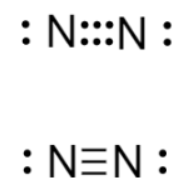Nitrogen gas is an extremely stable molecule because its structure contains which of the following?
A. Resonance bonds
B. Ionic bonds
C. Triple covalent bonds
D. Hydrogen bonds
The Lewis structure of nitrogen gas is shown below. Triple bonds are stronger than double or single bonds. Therefore, we can infer that the triple bond between the two nitrogen atoms makes nitrogen gas more stable.

Therefore, the Correct Answer is C.